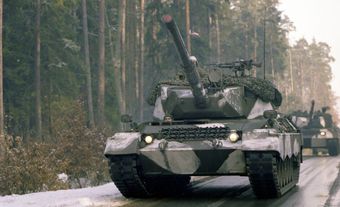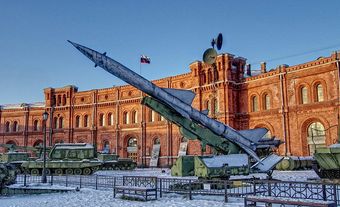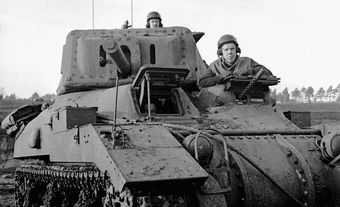The British introduced the Centurion main battle tank (MBT) in the closing days of the Second World War, although it did not see combat. The Centurion went on to become one of the most important British tanks ever developed and went through several upgrades. Canada purchased its first Centurions in 1952 and operated them until 1979. (See Armaments.)

Development
The British developed the Centurion because of the Second World War since their tanks were generally disappointing. In 1943, the British War Office issued a requirement for a new tank that could withstand a direct hit from German 88mm anti-tank guns, while its gun had to be able to penetrate German tanks’ armour.
Eventually, the British designed 13 marks of the Centurion as incremental updates were added. One major difference between the various marks was the calibre of the main gun. Centurions started with a 17-pounder (76.2mm) gun; the tanks were then quickly upgraded to the 20-pounder (84mm) and eventually the 105mm. The main gun was upgraded with a stabilizer, which meant it could fire on the move. Upgrades also included increased armour thickness, the addition of infrared sights for night vision, an external fuel tank and a .50 calibre ranging machine gun. (See Armaments.)
Use
The British produced 4,423 Centurions. The Centurion became one of the world’s longest-serving MBTs. Besides Britain and Canada, 17 other countries fielded the Centurion. Five nations used Centurions in combat.
Variants
The British produced several Centurion specialized variants, two of which were used by Canada. The armoured recovery vehicle (ARV) repaired and recovered tanks, while the armoured vehicle launching bridge (AVLB) carried a bridge to cross a 14-metre-wide river.
Centurion in Canadian Service
After the Second World War, Canada intended to “Americanize” its tanks. The Korean War, however, showed the need for a better tank than the American M-48 Patton tank, which was having production problems. Meanwhile, the Centurion had proven itself in Korea. In 1952–53, Canada purchased 274 Centurion Mk 3s equipped with 20-pounder guns at $126,344 each. (See also Canada and the Cold War; History of the Armed Forces in Canada.)
In March 1952, the first 21 Centurions arrived at the Royal Canadian Dragoons (RCD) tank squadron serving in Germany. In Canada, the Centurion equipped the remainder of the RCD, as well as Lord Strathcona’s Horse (Royal Canadians) and the Royal Canadian Armoured Corps School. (See Canadian Army.)

When the 8th Canadian Hussars (Princess Louise’s) and the Fort Garry Horse became regular force regiments in 1957 and 1958 respectively, they also used Centurions. In 1971, Canada fielded 322 Centurion MBTs (81 of which had 105mm guns), 9 ARVs and 4 AVLBs.
Eventually, all four armoured regiments rotated through Germany. Only the regiment in Germany, however, was fully equipped with the Mk 11 (105mm gun, .50 calibre ranging machine gun, infrared spotlights and sights and armoured external fuel tank).
In 1963, Canada presented a half-metre-long silver model of a Centurion tank, known as the Canadian Army Trophy, to NATO’s Northern Army Group for an annual tank gunnery competition. In 1967, the Strathconas won the trophy using Centurion tanks against four other nations.
By 1972, the Centurions were showing their age. It took until 1977 until Canada purchased the Leopard 1, but only for the Germany-based regiment and one squadron in Canada to support training.

 Share on Facebook
Share on Facebook Share on X
Share on X Share by Email
Share by Email Share on Google Classroom
Share on Google Classroom



